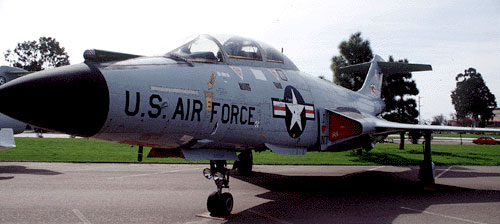|
The F-101 B "Voodoo" has roots going all the way back to the end of World War II. The XF-88 took shape at the McDonnell Aircraft Company's St. Louis, MO., facility. The XF-88 was to be a supersonic fighter that would escort our B-29, B-50 and B-36 heavy bombers deep into Soviet air space.

Design problems and changes in the Air Force's strategy resulted in a completely redesigned and redesignated aircraft. The first F-101 "Voodoo" took to the skies in September of 1954. The F-101 was built as a fighter interceptor and as a high speed single seat reconnaissance aircraft.
The reconnaissance "Voodoos," designated RF-101H, were instrumental in uncovering and monitoring the Soviet missile build up in Cuba during the Cuban Missile Crisis. The RF-101H also saw extensive service in Vietnam.
Our F-101B, the fighter-interceptor version, was used extensively by the United States Air Force's Air Defense Command to defend American airspace. The "Voodoo" was flown by frontline air force squadrons until 1971. The Air National Guard operated F-101s until the final type phase out which began in 1983.
The Canadian Armed Forces flew the CF-101 up to 1985. The Canadian Armed Forces have replaced their CF-101s with the McDonnell Douglas CF-18 "Hornet."
The last operational posting of our F-101B was with the 107th Fighter Interceptor Squadron of the New York Air National Guard. She then served as a maintenance trainer at Sheppard Air Force Base, Texas until acquired by the Travis Museum in 1986.
Specifications:
- Wing Span: 39'8"
- Length: 71'1"
- Height: 18'0"
- Maximum Weight: 51,724 Lbs.
- Maximum Speed: 1,094 M.P.H.
- Service Ceiling: 52,100 Ft.
- Range: 1,755 Miles
- Crew: 2
- Armament: 2 x Falcon Air-to-Air Missiles
- 2 x Genie Nuclear - Tipped Rockets
- Engine: 2 x Pratt & Whitney J-57-P-55 turbojets rated at 10,200 Lbs. thrust each max. without after burner. 16,900 Lbs. with after burner.
Information derived from “Travis Air Force Museum” by Nick Veronico copyright Travis AFB Historical Society/Jimmy Doolittle Air and Space Museum Foundation. This book is available from the Jimmy Doolittle Air and Space Museum GIFT SHOP located in the Travis Air Museum.
|